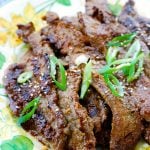Hearty, steaming, and flavorful bulgogi hot pot made with lots of vegetables! As long as you have some bulgogi, this elaborate hot pot is very easy to put together.

Bulgogi (불고기) is always wonderful grilled over an open flame or pan fried, but try making it into a hot pot (jeongol, 전골) with lots of vegetables. It becomes a whole new dish that’s hearty, steaming, and flavorful. Perfect for the cool fall and winter months!
Jeongol is a type of Korean stew with many variations such as haemul (seafood) jeongol, beoseot (mushroom) jeongol, mandu (dumplings) jeongol, etc. It’s an elaborate stew which is traditionally served in a wide, shallow pot called jeongol naembi (전골냄비).
Making bulgogi jeongol is fairly simple! First make bulgogi by marinating thinly sliced beef. It’s even better if you have leftover bulgogi.
Then, arrange a variety of fresh vegetables and bulgogi in a shallow pot, add some broth (or water), and cook. Depending on the size of your pot, you can cook in two batches, or you can add more ingredients as you cook, or take some out to eat if you’re cooking at the table.
You can certainly feed more people this way. One pound of meat will go a long way!
I like mushrooms so I usually add plenty of them – two to three varieties. I also use a couple of napa cabbage leaves. Green cabbage or bok choy will be great as well. Other add-in options are bean sprouts, radish (mu), and tofu.
Sweet potato starch noodles (dangmyeon, 당면) is also commonly added to this dish. The noodles are so good after soaking up the flavorful broth.
Bulgogi is sweet, so I don’t add sugar to the broth. The sweetness that the bulgogi releases makes the broth slightly sweet, not too sweet, but if you like it sweeter, add a little bit of sugar to the broth.
More jeongol (hot pot) recipes:
Haemul (seafood) jeongol
Beoseot (mushroom) jeongol
For more Korean cooking inspirations, follow along on YouTube, Pinterest, Twitter, Facebook, and Instagram.

Ingredients
- 1 pound thinly sliced beef rib eye or top sirloin - see note
For the Marinade
- 3 tablespoons soy sauce
- 1 tablespoon sugar
- 1 tablespoon honey or use more sugar
- 1 tablespoon rice wine or mirin
- 1 tablespoon garlic
- 1 tablespoon sesame oil
- 3 tablespoons grated Asian pear
- ⅛ teaspoon pepper
For the Broth (see note)
- 3 x 3 inches dried kelp dashima
- 3 ounces Korean radish cut into big chunks
- 1/4 onion
- 1 tablespoon soup soy sauce
- Salt and pepper to taste
For the vegetables
- 1 small carrot
- 2 large napa cabbage leaves or green cabbage or bok choy
- 1/2 medium onion
- 4 ounces assorted mushrooms button, shiitake, oyster, crimini, enoki, etc.
- 2 to 3 scallions
- 2 to 3 ounces minari water dropwort or watercress
- 1 red chili pepper - optional
For the optional noodles
- 3 ounces of sweet potato noodles dangmyeon, soaked in warm water for 20 minutes
Instructions
- Mix all the marinade ingredients in a large bowl. If using packaged pre-sliced meat, run a knife through it to cut into smaller pieces. Add the meat to the marinade. Toss gently, with hands, to mix everything well. Marinate while preparing the other ingredients.
- Put 5 cups of water and the broth vegetables in a medium size pot. Bring it to a boil over high heat. Reduce the heat to medium and continue to boil for about 15 minutes. Discard the vegetables. Season with the soup soy sauce, salt and pepper to taste.
- Cut the cabbage and carrot into thin, bite size pieces. Thinly slice the onion and mushrooms. Cut the scallions and minari in similar lengths.
- Using a wide, shallow pot, neatly arrange the bulgogi and vegetables in clusters. Add the optional noodles. Pour in 2 to 3 cups of broth and cook over high heat, separating the bulgogi pieces. Depending on the pot size, you can cook in two batches or add more broth and any remaining ingredients while eating if you’re cooking at the table.
Notes
You can use any type of broth (beef broth, anchovy broth, etc.) or simply use water.




























